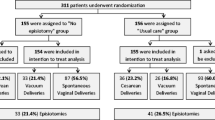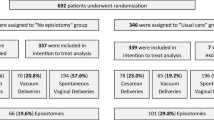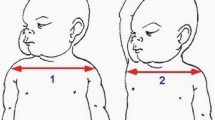Abstract
Introduction and hypothesis
To examine a common assumption that suturing of episiotomy, a straight performer-controlled incision, might be easier compared to repair of unpredictable spontaneous perineal tears.
Methods
Data for this study were collected prospectively, as part of a randomized controlled trial examining the outcomes of episiotomy avoidance. Suturing characteristics were compared between vaginal deliveries with episiotomy vs. spontaneous perineal tears. Primary outcomes included the duration of the repair, number of suture packs used for the repair, and subjective rating of suturing difficulty (rated from 1 to 5 by practitioner performing the suturing).
Results
Of 525 vaginal deliveries, episiotomy was performed in 165 (31.4%) of the cases, 59 of which (35.8%) were accompanied by additional vaginal tears. Spontaneous vaginal tears without episiotomy were noted in 272 deliveries (51.8%). Compared to spontaneous perineal tears, episiotomy performance was associated with an adverse effect on all three suturing characteristics in the overall cohort and in subgroup of non-operative deliveries. When comparing episiotomy only to second-degree tear suturing, in the subgroup of non-operative vaginal deliveries a higher rate of suturing duration < 10 min was noted in favor of spontaneous tears. However, in sub-analysis of vacuum-assisted deliveries, a benefit was noted in favor of the episiotomy-only group in terms of fewer suture packs and lower subjective difficulty.
Conclusions
In women with non-operative vaginal delivery, suturing of spontaneous perineal tears was easier and shorter compared to episiotomy repair. This might be related to the unpredictable nature of perineal tears, which might be shorter and shallower compared to the standard episiotomy incision.
Similar content being viewed by others
References
Sagi-Dain L, Sagi S. Indications for episiotomy performance—a cross-sectional survey and review of the literature. J Obstet Gynaecol. 2016;36(3):361–5.
Sagi-Dain Lena SS. Episiotomy knowledge, attitudes and practice: a cross-sectional survey of four public Israeli hospitals and review of the literature. Evid Based Midwifery. 2015;13(4):138–42.
Routine vs selective episiotomy: a randomised controlled trial. Argentine Episiotomy Trial Collaborative Group. Lancet. 1993;342(8886-8887):1517-8.
Sleep J, Grant A, Garcia J, Elbourne D, Spencer J, Chalmers I. West Berkshire perineal management trial. Br Med J (Clin Res Ed). 1984;289(6445):587–90.
Carroli G, Mignini L. Episiotomy for vaginal birth. Cochrane Database Syst Rev. 2009;1:CD000081.
Jiang H, Qian X, Carroli G, Garner P. Selective versus routine use of episiotomy for vaginal birth. Cochrane Database Syst Rev. 2017;2:CD000081.
Sagi-Dain L, Kreinin-Bleicher I, Bahous R, Gur Arye N, Shema T, Eshel A, et al. Is it time to abandon episiotomy use? A randomized controlled trial (EPITRIAL). Int Urogynecol J. 2020.
Blanc-Petitjean P, Meunier G, Sibiude J, Mandelbrot L. Evaluation of a policy of restrictive episiotomy on the incidence of perineal tears among women with spontaneous vaginal delivery: A ten-year retrospective study. J Gynecol Obstet Hum Reprod. 2020:101870.
Sangkomkamhang U, Kongwattanakul K, Kietpeerakool C, Thinkhamrop J, Wannasiri P, Khunpradit S, et al. Restrictive versus routine episiotomy among southeast Asian term pregnancies: a multicentre randomised controlled trial. BJOG. 2020;127(3):397–403.
Manzanares S, Cobo D, Moreno-Martinez MD, Sanchez-Gila M, Pineda A. Risk of episiotomy and perineal lacerations recurring after first delivery. Birth. 2013;40(4):307–11.
Sagi-Dain L, Sagi S. Morbidity associated with episiotomy in vacuum delivery: a systematic review and meta-analysis. BJOG. 2015;122(8):1073–81.
Lund NS, Persson LK, Jango H, Gommesen D, Westergaard HB. Episiotomy in vacuum-assisted delivery affects the risk of obstetric anal sphincter injury: a systematic review and meta-analysis. Eur J Obstet Gynecol Reprod Biol. 2016;207:193–9.
Author information
Authors and Affiliations
Corresponding author
Ethics declarations
Conflicts of interest
None.
Additional information
Publisher’s note
Springer Nature remains neutral with regard to jurisdictional claims in published maps and institutional affiliations.
Rights and permissions
About this article
Cite this article
Sagi-Dain, L., Kreinin-Bleicher, I., Shkolnik, C. et al. In women with spontaneous vaginal delivery, repair of perineal tears might be easier compared to episiotomy. Int Urogynecol J 32, 1727–1732 (2021). https://doi.org/10.1007/s00192-020-04642-5
Received:
Accepted:
Published:
Issue Date:
DOI: https://doi.org/10.1007/s00192-020-04642-5




